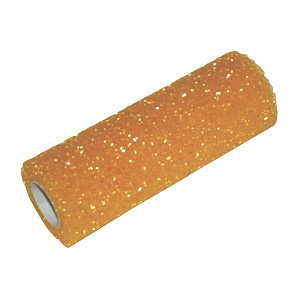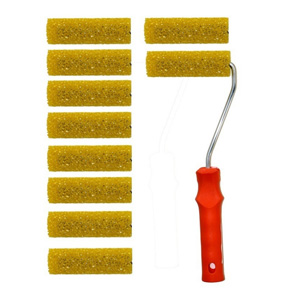Ready to start painting? | ||
Once you have completed your surface preparation, you're ready to start painting. Please try to contain your enthusiasm and excitement for a moment, and just pause to make sure you have everything ready for trouble free painting. Temperature: Tuff Cab is best applied at room temperature. Avoid painting in an exceptionally cool environment (below 10°C) as the drying/curing time increases significantly. Below 5°C the paint will not form a surface skin and WILL NOT HARDEN. Tuff Cab cures best at Room Temperature. Also avoid paint in high temperatures, temperatures significantly above 25°C can result in the Tuff Cab surface drying very quickly, and its difficult to apply a thin coat at higher temperatures. At room temperature, the first coat will usually dry in around 30-60 minutes (dependent on application thickness and temperature) In a cooler environment, up to 2-4 hours is common for the first coat. Subsequent coats will normally take a little longer, but its best to apply additional coats more sparingly to help ensure hard layers of paint. A second heavy, textured coat may take up to 24 hours to fully dry in cool conditions. Painting in the heat: On a hot summer's day it may be very tempting to get all your speakers out in the garden and give them a fresh coat of paint. We advise you try to pick a slightly cooler day. Summer heat with temperatures around 30°C, the paint can dry in as little as 10-15 minutes, sometimes making it difficult to finish a panel with an even coat, rapid drying time like this will tend to increase the possibility of roller marks from the edges of the roller. With the paint drying whilst you are rolling it on, it is commopn for the texture to become a little 'spiky' making the surface feel very rough, almost like sandpaper. If this does happen, let the paint dry fully, and then lightly sand the surface before applying a final thin coat (in the shade!) Are you prepared? First, wear appropriate clothing. If you get TuffCab on your clothes: whilst its still wet, you can rinse it out with lots of water, and providing it doesnt dry, it will come out with standard detergent, however once it starts to cure, then it wont come out, ever. Wear some old clothes or suitable overalls. Gloves, whilst not essential, are advisable, as above, whilst wet, the paint washes off easily, but once it starts to cure, its very difficult to remove. Although Tuff Cab is not known to be harmful, skin irritation is possible with any paint, so its best to avoid getting it on your hands. Its best to paint in a well ventilated area, although not known to be harmful, there will be some vapours released from the paint as it cures, and its best to minimuse your exposure to any vapours. A big warehouse, or shaded/sheltered area outside is ideal.
 After you have covered a panel, you might find you are struggling to even out the textured effect, this can be difficult on larger panels. We have a solution, use a 9" roller to smooth the texture, BUT DONT DIP THE ROLLER into the paint tub - use the roller DRY, and just gently roll it through the texture you made with the 4" roller. The 9" roller will absorb a LOT of paint, if you dip it in the tub, you will need 250-300 grams of paint to soak the roller fully, and then you will have the same problem evening out the texture with the 9" roller as you did with the 4" roller. The 9" roller is best used for smoothing over only. You are superimposing texture over existing texture to make a more even effect. After you have covered a panel, you might find you are struggling to even out the textured effect, this can be difficult on larger panels. We have a solution, use a 9" roller to smooth the texture, BUT DONT DIP THE ROLLER into the paint tub - use the roller DRY, and just gently roll it through the texture you made with the 4" roller. The 9" roller will absorb a LOT of paint, if you dip it in the tub, you will need 250-300 grams of paint to soak the roller fully, and then you will have the same problem evening out the texture with the 9" roller as you did with the 4" roller. The 9" roller is best used for smoothing over only. You are superimposing texture over existing texture to make a more even effect.Dont panic if you cant get your texture perfect in the first coat, its virtually impossible to do. Also, resist the temptation to keep adding more paint and making a thicker and thicker coat, it will just get harder to even out. Move on to the next panel, and let the first coat dry. Once you've completed all the panels you can access easily, leave the first coat to dry. Handy Hint: You dont need to wash your roller our between coats, just wrap it in a plastic bag, or cling film to avoid exposure to the air, and then take the plastic off when doing the next coat - the paint and roller will stay fresh for a few days under the plastic saving you cleanup time! Ready for the second coat? First check over your first coat, any slight imperfections can be lightly sanded before applying the next coat. If you didnt quite get it right, and the first coat feels rough and spiky like sandpaper, you can easily fix this with the second coat, just rub down very lightly, and carry on with the second coat, the problem will go away. Follow the same procedure for the second coat, use the 4" roller to apply, and the 9" roller to even out the texture, gradually you will build texture over texture and you will get an even,random, stippled effect. The second coat usually required less paint, as the first coat has sealed the wood, and the surface is less porous. Dont try to paint just one thick coat. It will go wrong. We've tried it, its difficult, and you'll get uneven coverage, roller marks, and a less durable surface. Tuff Cab will first dry out, as the water content of the paint will be absorbed into the wood and/or evaporate into the air. Once its dry, it starts to cure, and as it cures the acrylic resin in the paint will harden ON THE SURFACE. The surface of the paint, thats exposed to air gets harder quicker. So it's best to apply several thin coats, as each surface hardens separately, giving you an overall harder finish. Doing 2-3 thinner coats will give a much more even texture, and a more durable coating. Want less texture? No problem, just use a standard short pile emulsion roller. Each coat will be thinner, and much less textured, 3-4 coats will give a slight texture a bit like a leather effect. You can also use a short pile roller when touching up a previously painted cabinet that already has a thick enough texture.
| ||





 Got yourself tooled up? TuffCab is easy to use, and very versatile, but it helps to make sure you have the right tools on hand for the effect you want to achieve. If you are painting bare wood, and want a textured effect, we recommend using our honeycomb rollers. The 4" roller is just the right size to dip straight into a 5kg tub of Tuff Cab, saves making a mess in a roller tray. You can just dip in the pot and apply straight to the wood and start rolling. Roll in different directions, and spread the paint out over a full panel trying to ensure even coverage over a complete panel. Pay special attention to areas with end grain exposed, as this will require more thorough coating with paint. Our 4" rollers come in packs of 10 for convenience.
Got yourself tooled up? TuffCab is easy to use, and very versatile, but it helps to make sure you have the right tools on hand for the effect you want to achieve. If you are painting bare wood, and want a textured effect, we recommend using our honeycomb rollers. The 4" roller is just the right size to dip straight into a 5kg tub of Tuff Cab, saves making a mess in a roller tray. You can just dip in the pot and apply straight to the wood and start rolling. Roll in different directions, and spread the paint out over a full panel trying to ensure even coverage over a complete panel. Pay special attention to areas with end grain exposed, as this will require more thorough coating with paint. Our 4" rollers come in packs of 10 for convenience.